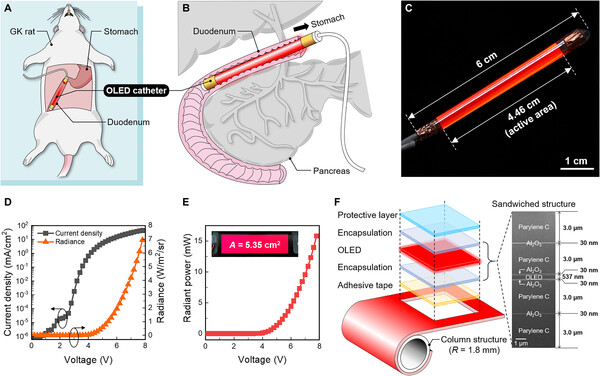A research team at the Korean Advanced Institute of Science and Technology (KAIST) and Asan Medical Center (AMC) said that they have developed the "world's first" organic light-emitting diode (OLED)-based catheter for phototherapy within internal organs.

Traditionally, the application of light therapy was restricted to external use due to factors such as absorption and scattering of light within the skin. However, the technology developed by the two institutions enables the treatment to be extended to internal organs.
The device developed by the joint research team, led by Professors Yoo Seung-hyup at KAIST and Park Do-hyun at AMC, is a catheter-shaped OLED platform that can be directly inserted into tubular organs like the duodenum and is water-resistant.
It emits light uniformly in all directions when wrapped around a cylindrical structure. Benefiting from OLED's low-heat emitting property, the catheter prevents tissue damage during insertion. Also, as the catheter is manufactured using biocompatible materials, it minimizes potential side effects.
A team at the Electronics and Telecommunication Research Institute also participated in the study.
The team used the device to explore its potential in improving Type 2 diabetes, a prevalent condition among modern adults.
In an animal study conducted on Type 2 diabetes rat models, the team observed a significant reduction in blood sugar levels and insulin resistance when 798 millijoules (mJ) of light energy was delivered to the duodenum.
There were also signs of reduced liver fibrosis and other improvements.
"Securing OLED technology for biomedical applications is a vital step in diversifying an industry traditionally dominated by display and lighting sectors," Professor Yoo said. "This research exemplifies the importance of collaborative efforts between device and medical experts."
Professor Park also said, "OLED light exposure in the duodenum seems to influence gut microbiota, promoting the growth of beneficial bacteria and reducing harmful ones, thus improving blood sugar levels, reducing insulin resistance, and inhibiting liver fibrosis in Type 2 diabetes."
However, Professor Park added that while the ideal characteristics of OLED present numerous potential applications for in-body light therapy, it is crucial to remember that these results, though promising, were derived from small animals.
As a result, Park stressed the need for further verification from small to large animals and, ultimately, humans.
Science Advances published the result of the study in its online edition on Sep. 1.

